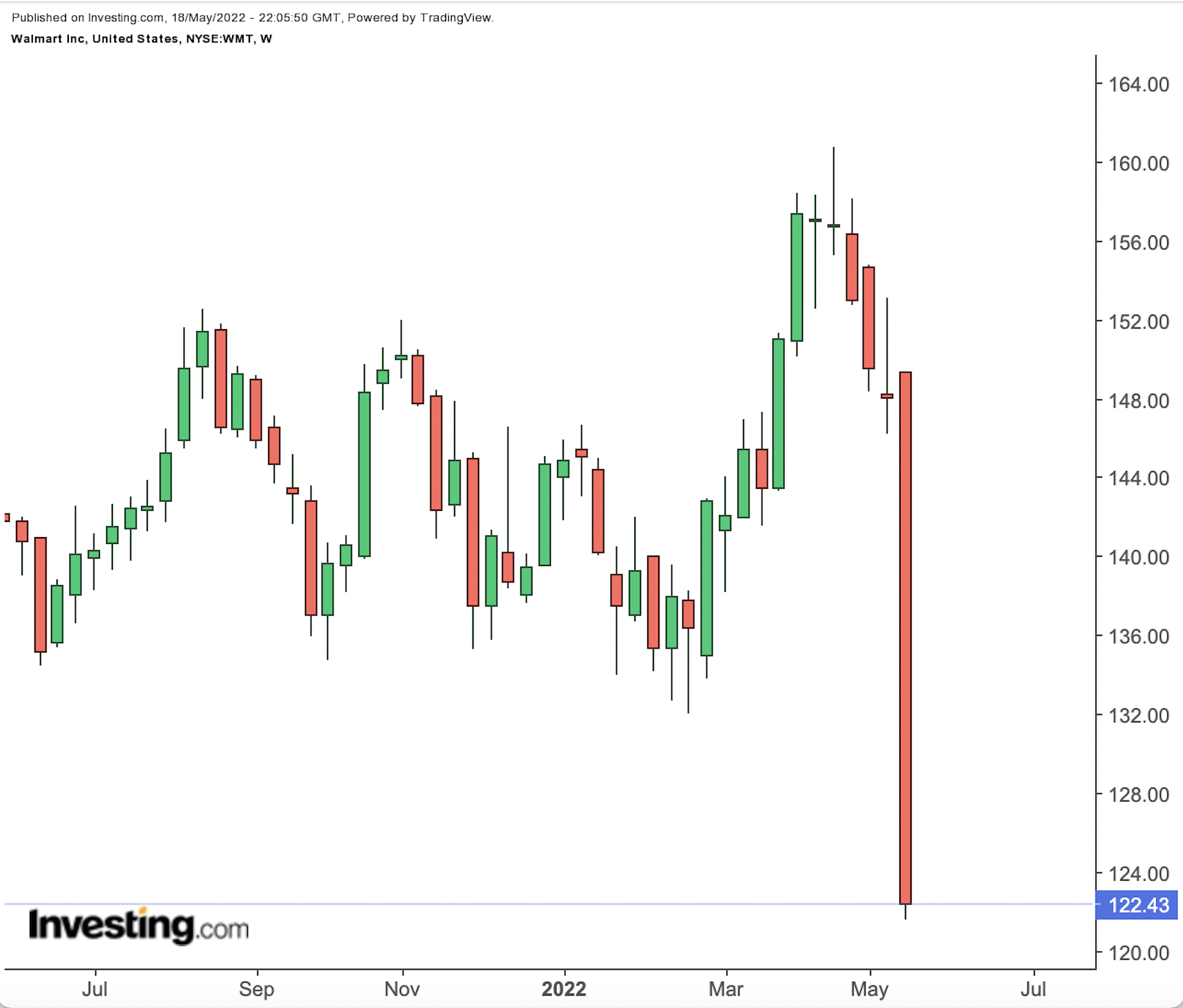Shares of Walmart (NYSE:WMT) closed 11.38% lower on Tuesday after the retail giant reported FQ1 2023 earnings that were well below analysts’ expectations. This marked the worst daily drop for Walmart shares since 1987.

Source: Investing.com
How Did Walmart Perform in Q1?
Walmart shares fell to a 52-week low on Tuesday after the company reported disappointing results and offered soft guidance.
The retailer reported Q1 adjusted earnings per share (EPS) of $1.30, missing the consensus estimates of $1.48 per share. Revenue came in at $141.57 billion in the quarter, up from $138.31 billion in the same period last year and above the analyst estimates of $138.94 billion.
Q1 net income stood at $2.05 billion, or 74 cents per share, down from $2.73 billion, or 97 cents per share in the same period last year.
Walmart’s U.S. same-store sales rose 3% from the same period last year, and 9% on a two-year basis. E-commerce sales climbed 1% and 38% on a one-year and two-year basis, respectively. Same-store sales at Sam’s Club advanced by 10.2% from a year ago, and by 17.4% from two years ago.
Walmart’s best-selling category, groceries, were among the troubled categories in the first quarter as food costs soared 9.4% in April, compared with the same period last year. For comparison purposes, the health-care sector was Walmart's fastest-growing business in the previous quarter. Walmart Health offers medical, dental and optometry services. The massive retailer remains one of the largest optical retailers in the U.S., though sales from optical services have declined, despite being offered at more than 3,000 locations.
Walmart hiked its sales guidance for fiscal 2023, anticipating net sales growth of around 4% in constant currency, up from the previously expected increase of 3%. On the other hand, the retailer trimmed its profit outlook, saying it now expects full-year EPS to decrease by roughly 1% compared to the previously anticipated mid-single-digit growth.
Why Are Investors Turning More Cautious On Walmart?
Investors and economists have been impatiently awaiting Walmart’s earnings report to see how the U.S. consumers are coping with record-high inflation levels.
Walmart CEO Doug McMillon said Tuesday that the retailer’s Q1 results “were unexpected and reflect the unusual environment” as the consumer price index (CPI), which gauges the prices of goods and services, surged 8.3% last month from a year ago.
CFO Brett Biggs added that expensive gas prices, higher labor costs and inventory levels have affected the company’s performance. Delay in merchandise shipments and weaker-than-expected sales of some products such as plants and pool chemicals due to colder weather have also weighed on Walmart’s results.
Furthermore, Biggs said that Walmart employees returned from coronavirus leave quicker than anticipated, leading to overstaffing and scheduling issues in the quarter. On a more positive note, Biggs said the second quarter is “off to a good start from a sales perspective.”
Walmart announced an hourly wage increase in September 2021 by at least $1 for more than 565,500 store employees as the retailer sector grappled with a tight labor market. At the time, CEO John Furner said the move marked the third wage hike Walmart had made in the past year, with the U.S. average hourly wage now standing at $16.40.
The wage hike affected employees who were working on the front end of retail stores as well as in Walmart’s food and consumable and general merchandise departments. The hike increased the minimum hourly wage from $11 to $12, though still lower than the $15-per-hour minimum wage at its competitors Amazon (NASDAQ:AMZN) and Target (NYSE:TGT).
Not long before the wage hike, Walmart also announced its plan to hire 20,000 new employees for its supply chain ahead of the holiday season. Furthermore, the world’s largest company by revenue said in July it would pay 100% of college tuition and books for its employees.
How Are Investors Feeling About Walmart?
As inflation hovers around record levels, Walmart has been raising its prices at a slower pace compared with its competitors in an effort to appeal to customers. The move likely affected the retailer’s profits in the first quarter.
The company also said it noticed a change in consumers’ buying patterns as a result of inflation as more customers have been buying private-label food brands and turning away from discretionary products.
Walmart shares were most hit by management’s comments about consumer sentiment and elevated inventory levels. While investors are likely to stay generally positive on Walmart on the back of the inflation-fuelled high pricing, all eyes will remain on costs and demand.
Moreover, some investors are very likely to see this pullback as a stock trading opportunity to buy Walmart shares as the company still offers a shelter to hide in a highly-uncertain macro environment.
Conclusion
Walmart shares fell sharply after the company reported lower-than-expected Q1 results as margins missed analyst expectations. Rising costs also weighed on the guidance with shares suffering the worst daily drop since 1987.
